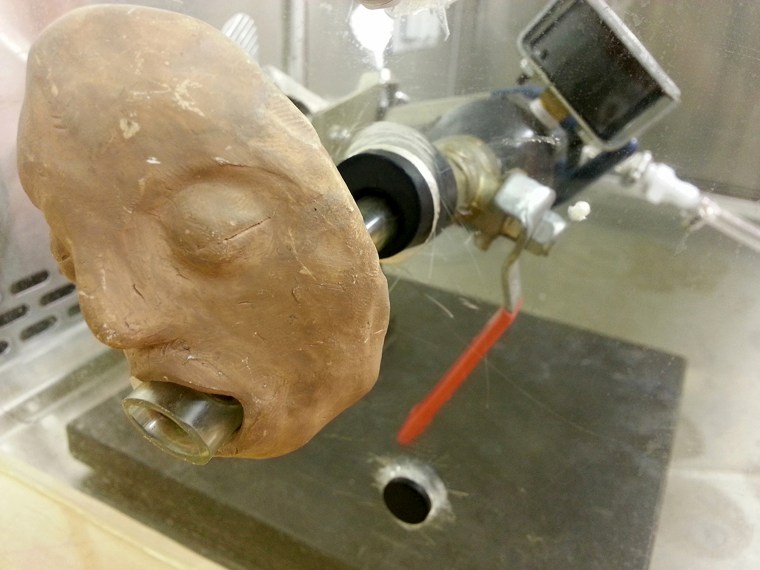Researchers have invented a “vomiting machine” that demonstrates just why the nauseating norovirus spreads so far and so fast.
The nasty stomach bug can infect hundreds of passengers on a cruise ship, or every single person who sits at the same restaurant table as a victim. It sticks to silverware and counters, and survives being dried out for weeks.
Scientists had also suspected that it floats in the air and spreads that way, too. But no one had actually demonstrated that it could.
Grace Tung-Thompson and colleagues at North Carolina State University and at Wake Forest University designed a device that they hope would perfectly replicate what happens when someone pukes, from a feeble dribble of bile to the explosive projectile vomiting that is one of the hallmarks of a norovirus infection.
It’s got a little tube that replicates the throat, and it’s designed to push out liquids and semi-liquids in the same, downward-facing direction that people do when they barf.
“This machine may seem odd, but it’s helping us understand a disease that affects millions of people,” says Lee-Ann Jaykus, the N.C. State food science professor who oversaw the work.
They used a range of materials, including instant vanilla Jell-o pudding, to replicate various textures of vomitus. The biggest sticking point was how to replicate norovirus, which doesn’t really like to grow in a lab dish and which the researchers wouldn’t want to risk catching anyway.
"There was evidence of aerosolized MS2 (the norovirus stand-in) after every simulated vomiting episode."
They used another virus called MS2 that’s similar to norovirus, that doesn’t make people sick and that’s easy to grow in the lab.
"We put it in the vomitus, we let the machine go and then we capture the aerosol," Jaykus said.
"We think that there’s a at least a million particles released in a vomiting event and maybe more."
Not all of it goes into the air. In fact, very little did in their experiments. But it was enough. They estimate that as many as 13,000 virus particles can be released into the air with a single retch. They made a video that shows how it works.
"There was evidence of aerosolized MS2 after every simulated vomiting episode," they wrote in their report, published in the Public Library of Science journal PLoS ONE.
People can be infected with as few as 20 to 1,300 microscopic viral particles, so their study shows that vomiting could indeed spread the infection through the air.
"It would probably be enough to make somebody sick," Jaykus said.
“When one person vomits, the aerosolized virus particles can get into another person’s mouth and, if swallowed, can lead to infection,” Jaykus added in a statement.
“But those airborne particles could also land on nearby surfaces like tables and door handles, causing environmental contamination. And norovirus can hang around for weeks, so anyone that touches that table and then puts their hand to their mouth could be at risk for infection.”
“When one person vomits, the aerosolized virus particles can get into another person’s mouth and, if swallowed, can lead to infection."
The findings help explain a 2012 study that showed how the virus spread on a plastic bag that had been in a bathroom where a norovirus patient threw up.
“There are 21 million cases of human norovirus infection in the U.S. each year, and this virus genus is now recognized as the leading cause of outbreaks of acute gastroenteritis,” the researchers wrote.
It kills up to 800 people a year in the U.S. alone and puts 70,000 into the hospital, so understanding how it spread sand finding ways to stop it could prevent many illnesses, the researchers said.
“This is work that can help us prevent or contain the spread of norovirus — and there’s nothing odd about that,” Jaykus said.
The next step might be to set up the apparatus in a room and see how the virus moves at it clings to bits of mucus and stomach acid and even food that gets sprayed into the air.
"It could be a really cool study," Jaykus said.

